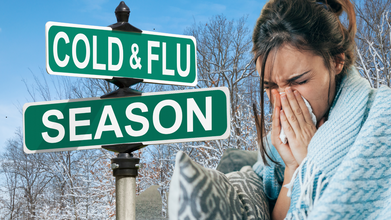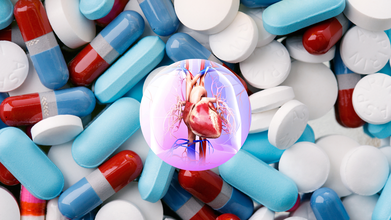- Health Conditions A-Z
- Health & Wellness
- Nutrition
- Fitness
- Health News
- Ayurveda
- Videos
- Medicine A-Z
- Parenting
- Web Stories
Air Pollution Can Worsen COPD: Follow These Expert-Recommended Preventive Measures

Air Pollution (Credit: Canva)
As air quality in Delhi-NCR worsens, the focus has shifted to protecting oneself from respiratory diseases. While experts are advising residents to wear masks and stay indoors, many have expressed concerns about safeguarding the health of those suffering from Chronic Obstructive Pulmonary Disease (COPD). Air pollution, besides smoking, is the major cause of this serious health condition that is primarily characterized by difficulty in breathing. A person suffering from COPD experiences frequent coughing, wheezing, shortness of breath, fatigue, and frequent respiratory infections.
Dr Sandeep Nayar, Chest & Respiratory Diseases expert at BLK-Max Super Speciality Hospital, Delhi said that long-term exposure to pollutants in the air could increase a person's chances of contracting COPD. He added that the respiratory tract is particularly susceptible to ill effects of air pollution, even more than other systems in the body.
"Long-term exposure to air with a high concentration of pollutants may increase the incidence of COPD. The increased concentrations of various air pollutants, such as Ozone, Nitrogen oxides, Sulphur oxides, PM 2.5 etc. can not only increase in the number of COPD cases but also result in worsening and increase the risk of mortality in patients who are already suffering from COPD. So, rising air pollution is definitely a cause of concern for Delhi-NCR residents," he said.
Precautions COPD Patients Should TakeAccording to Dr Nayar, one should avoid going out until it is necessary. In case they really need to go out, they should cover their face with a mask, preferably N95. "Try to eliminate the source of pollution if possible. Keep your indoor pollution less by keeping it smoke-free. Avoid burning wood, candles, cigarettes, incense sticks, avoid perfumes or exposure to other chemicals, and irritants," he said. People staying indoors, especially elderly age groups, may consider the installation of appropriate Air Purifiers. The most effective way to improve air quality in your home is to ventilate with clean, outdoor air.
It is very important for the patients who are on inhalers, to continue them as prescribed by physicians and not stop medication even if they are feeling fine until & unless told by their doctors.
One key piece of advice Dr Nayar gave to all COPD patients is to avoid activity outdoors when outdoor pollution levels are high. They also need to keep themselves hydrated and ensure proper nutrition in their diets. "Keep yourself covered and wear a mask when you are going out. Even in the presence of the slightest of symptoms, contact your doctor as early intervention will prevent you from worsening of symptoms," Dr Nayar asserted.
NHS Issues Flu Jab SOS; Is UK To See The Worst Flu Season?

Credits: Canva
NHS has now issued a "flu jab SOS" as fears grow that the flu cases will add up to a brutal winter. While it is every winter that the flu strikes, this year, there is something different. A seasonal flu usually mutates in the summer and thus evade some of our immunity, which may have kicked in early flu season before. A seasonal flu is thus a type that has a history of being more severe.
All thanks to flu staying all round the year, flu experts have now said that they won't be shocked if this flu season becomes the worst flu season for a decade.
Professor Nicola Lewis, the director of the World Influenza Center at the Francis Crick Institute told BBC, "We haven't seen a virus like this for a while, these dynamics are unusual. It does concern me, absolutely. I'm not panicking, but I am worried."
What Is Happening To Flu Season This Year?
Scientists have been able to track the evolution of influenza viruses because they mutate constantly, and thus the flu vaccines have to be updated every year to keep up. The evolution happens in a rhythm which is known as the "shift and drift". Most of the time the virus undergoes a minor change, however, every often there is also a sudden attempt for an abrupt shift as the virus keeps mutating.
Prof Derek Smith, who heads the Centre for Pathogen Evolution at the University of Cambridge, says seven mutations in a strain of the H3N2 seasonal flu have caused a rapid rise in cases involving this altered version of the virus.
Unusually, this spike happened outside the typical flu season, right in the middle of the northern hemisphere’s summer. “It will almost certainly spread worldwide, and quickly,” says Prof Smith. By September, once schools reopened and temperatures began to fall, cases started rising again.
Experts are still studying the exact impact of the mutations, but they likely help the virus slip past some of the immunity people have developed from past infections and vaccines. This makes it easier for the virus to infect and spread, which is why flu season has arrived early in the UK and countries like Japan.
If the virus spreads more easily, it doesn’t need to wait for cold winter conditions, when people stay indoors with closed windows, to trigger flu season. “We’re already far ahead,” says Prof Lewis. “This is likely to be a strong flu season.”
Using R numbers as a guide, the new mutated strain appears to have an advantage. Seasonal flu normally has an R value of about 1.2, but this year’s early estimates put it closer to 1.4. That means if 100 people were infected, they would typically spread it to 120 others, but this year that number could be around 140.
Could This Be The Worst Flu Season?
Professor Christophe Fraser, from the Pandemic Sciences Institute at the University of Oxford told BBC, "It's highly likely it's going to be a bad flu season and it's going to happen quite soon, we're already well into it. There are indicators that this could be worse than some of the flu seasons we've seen in the last 10 years."
In a normal flu season, about one in five people get infected, but that number could be higher this year, he warns. Still, there’s a lot of uncertainty around these predictions.
Many look to Australia for hints, since it saw its worst flu season on record, although it was dealing with a different H3N2 strain than the one spreading now.
Right now, the virus is circulating rapidly among children, especially in schools where germs spread easily. But the immunity of a 10-year-old is very different from that of an older adult, who has lived through many more flu seasons and carries different immune memory.
Because of this, experts will be watching closely as infections begin to move into older age groups in the coming weeks.
Why Cancer Cases In India On The Rise? Here's What Doctors Say

Credits: Canva
India is facing a worrying rise in cancer cases, and top oncologists Dr. Gopal Sharma and Dr. Rakesh Kumar Agarwal, as reported in Times Of India have shred shedding light on the key problems. As per the doctors, factors like pollution, poor diet, obesity, and delayed diagnosis are the main drivers behind this surge, especially outside major cities. The battle against cancer, they stress, requires a holistic approach combining modern oncology, traditional medicine, and preventive care.
Pollution: The Silent Carcinogen
Air pollution is a major contributor to the rise in cancer. Dr. Gopal Sharma explains that fine particles like PM2.5 and PM10 cause chronic inflammation and oxidative stress, which slowly damages our DNA and can trigger tumor growth.
Dr. Rakesh Kumar Agarwal adds that the toxic mix of chemicals in polluted air, such as nitrogen oxides and benzene, acts as a silent carcinogen. These toxins don't just affect the lungs; they are linked to rising cases of breast, bladder, throat, and gastrointestinal cancers. Alarmingly, many of these new cases are appearing in non-smokers and at younger ages. The danger isn't limited to urban smog; indoor cooking smoke in rural households also poses a significant risk.
The Accessibility Gap Between Rural And Urban Areas
In rural India, cancer is often found too late, leading to much lower survival rates. Dr. Gopal Sharma points out that limited access to screening services, low awareness, and financial constraints prevent many people from getting checked until it’s too late. Cancers like breast and cervical, which are highly treatable when caught early, often go undetected until they are advanced.
Dr. Rakesh Kumar Agarwal highlights that many villagers first seek help from local healers or untrained providers, dismissing early symptoms as minor. Precious months pass during these delays, resulting in a flood of late-stage cases where curative options are limited. The clear solution, both doctors stress, is to take healthcare to the people using mobile screening vans and teleconsultations to bring care closer to communities.
Diet, Diabetes, and Cultural Barriers
Dietary habits play a significant role in cancer risk. Diets heavy in fried foods, processed snacks, and high salt can fuel metabolic and gastrointestinal cancers. Conversely, a traditional Indian diet rich in lentils, whole grains, and vegetables can help protect the body. The surge in obesity and diabetes further fuels cancer risk (like breast, pancreatic, and liver cancers) by creating metabolic imbalances and persistent inflammation. Tackling these metabolic conditions early is a powerful preventive tool.
Cultural taboos and stigma also lead to delayed diagnosis, particularly among Indian women. Fear of social stigma, family pressure, or concerns about marriage and infertility cause women to delay seeking help for breast and reproductive health issues. Oncologists believe that open dialogue, normalized through collaboration with schools and the media, is essential for timely detection.
For advanced treatment like immunotherapy and precision oncology, the main barriers are high cost, poor insurance reimbursement, and lack of infrastructure in Tier II and III cities. Broader insurance inclusion and government-funded programs are needed to make these treatments accessible.
The experts agree that cancer care should be a three-pronged approach: awareness, accessibility, and accountability. They propose integrating traditional modalities like Ayurveda, yoga, and mindful eating with evidence-based oncology to enhance patient compliance, reduce stress, and promote holistic recovery. Ultimately, the war against cancer will be won not just in labs and hospitals, but through better daily choices, cleaner air, healthier food, and smarter public policies.
Five Every Day Drugs That Could Negatively Impact Your Heart, According To Doctor

Credits: Canva
Every medicine has its own set of side effects, and Dr Dmitry Yaranov, a Russia-based cardiologist, who specializes in heart failure, advanced heart failure, heart transplantation, and mechanical circulatory support, says that some everyday drugs can pose hidden risks to the heart. His message is not meant to spark fear but to encourage awareness about medications we often assume are completely harmless.
Below are five categories of common drugs that Dr. Yaranov believes deserve more caution, especially for those with existing heart issues.
NSAIDs - Nonsteroidal Anti-inflammatory Drugs
These are your everyday painkillers, which includes ibuprofen or naproxen. While they are go-to options for headaches, fever, or muscle cramps, Dr Yaranov says that its frequent use could strain the heart.
These drugs reduce inflammation by blocking certain chemical pathways, but they also make the body retain salt and water. This can:
- Raise blood pressure
- Worsen swelling
- Increase the risk of heart failure, particularly in people who already have high blood pressure or heart disease
Dr. Yaranov suggests discussing long-term or frequent NSAID use with a doctor, instead of using them casually.
Chemotherapy Drugs
While these drugs are life-saving, it may have side effects that could weaken the heart muscles. Dr Yaranov explains that drugs like doxorubicin or trastuzumab could also affect how well the heart pumps blood, which can lead to ardiomyopathy or heart failure.
Because of this, many cancer centres now include routine heart monitoring before, during, and after chemotherapy. The goal is to fight cancer without compromising long-term heart health.
Stimulant Medicines For ADHD
Stimulants that contain amphetamines help improve focus and alertness, but Dr. Yaranov warns that they can also:
- Increase heart rate
- Raise blood pressure
- Trigger arrhythmias
Elevate the risk of heart attack in people who have underlying heart issues
He stresses that misuse or unsupervised use is especially dangerous. Even for those who take them as prescribed, regular follow-ups with a doctor are important.
Older Diabetes Medications
Managing diabetes could mean being on medicines for lifelong. Yaranov points out that older drugs like rosiglitazone can increase the risk of heart failure despite effectively lowering blood sugar. Because of these concerns, many doctors now prefer newer diabetes medications that also support cardiovascular health. However, patients should never switch or stop medicines without medical guidance.
Common Cold Medicines
Thanks to allergens and climate change, common cold now stays all around the year, which means you will be taking cold medicines frequently and for a longer stretch. These medicines contain pseudoephedrine that work by narrowing blood vessels to relieve nasal congestion, however, Dr Yaranov says that they can also:
- spike blood pressure
- Disturb normal heart rhythms
- Increase strain on the heart
For individuals with hypertension or heart disease, Dr. Yaranov advises avoiding these drugs or using them only after consulting a healthcare provider.
Dr. Yaranov’s core message is simple: even routine medications have side effects worth understanding. Being informed helps people protect their cardiovascular health, especially if they already have heart risk factors. The goal is not to avoid necessary treatment but to use medicines wisely and stay in regular touch with your doctor.
Note: This article is based purely on the remarks shared by Dr. Dmitry Yaranov. Health and Me does not recommend discontinuing or changing any medication without first consulting your doctor.
© 2024 Bennett, Coleman & Company Limited

